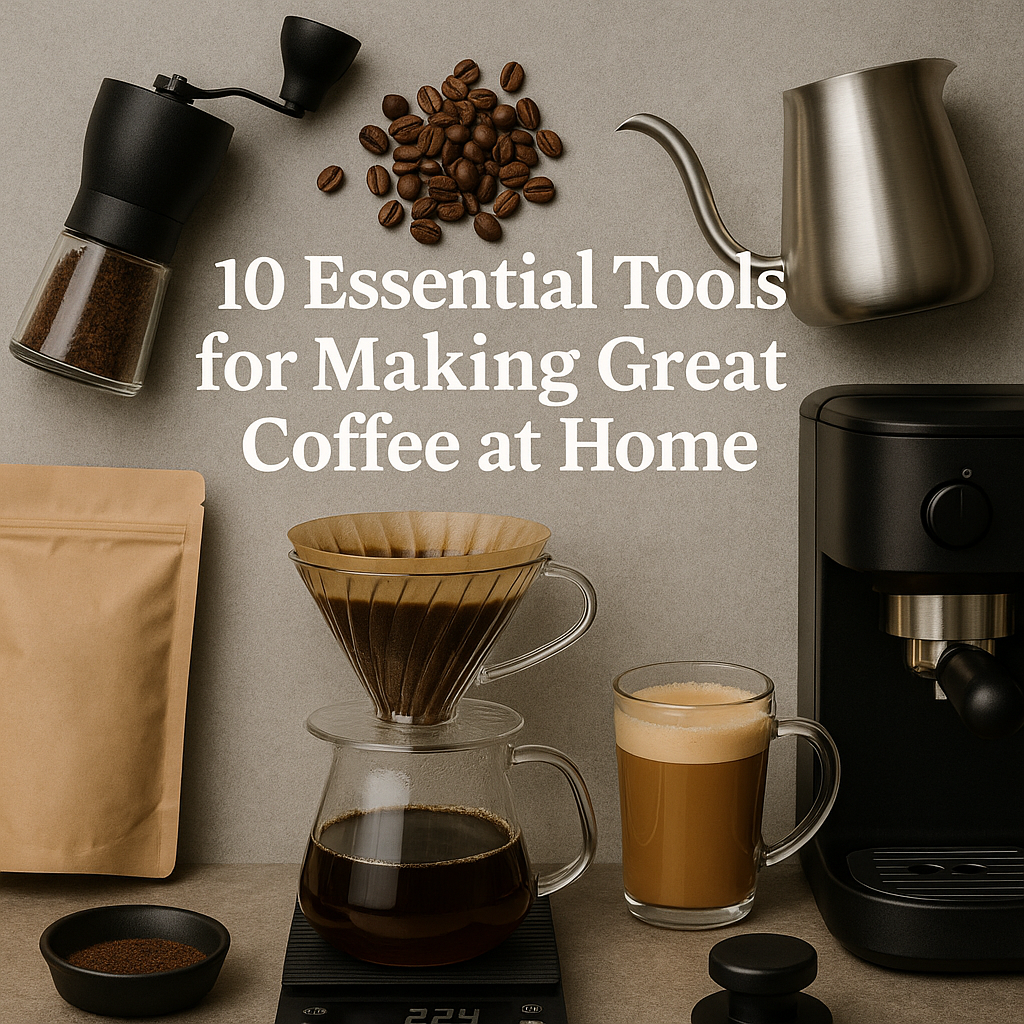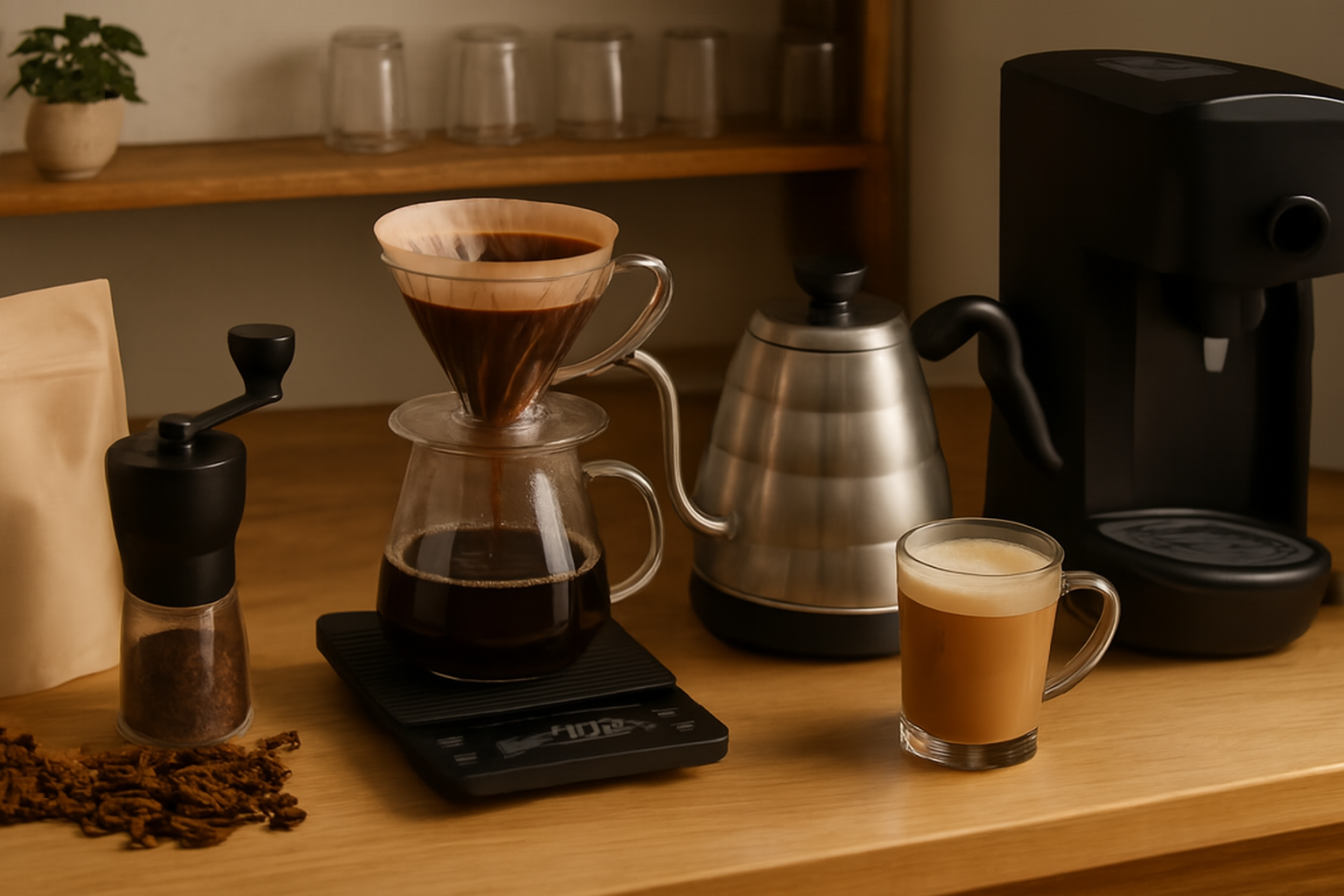Preparing great coffee at home is both an art and a science. It’s not just about pouring hot water over ground beans — it’s about precision, control, and understanding the chemistry behind each cup. The good news is that you don’t need a café-sized setup to brew like a pro. With the right tools and some technique, anyone can make barista-level coffee in their kitchen. In this article, we’ll explore ten essential tools that will transform your home coffee experience, whether you’re just starting out or already on your way to becoming a serious home barista.
Why Tools Matter in Coffee Brewing
Many people invest in quality beans and then ruin the experience by using poor equipment. A cheap blade grinder or inconsistent water temperature can turn a premium single-origin bean into a bitter or weak disappointment. On the other hand, using proper tools allows you to extract the best flavors and textures from each coffee you brew.
1. Burr Grinder
If you only invest in one coffee tool, make it a burr grinder. Unlike blade grinders, which chop beans unevenly, burr grinders crush them between two abrasive surfaces to produce a consistent grind size. This consistency is essential for proper extraction — the key to great taste.
There are two main types of burr grinders:
- Manual burr grinders: Compact, quiet, and often more affordable, they’re great for small batches or travel.
- Electric burr grinders: More powerful and consistent for daily use, especially when brewing multiple cups or experimenting with different methods.
With a burr grinder, you can adjust grind size to suit various brewing methods, from espresso to French press. This precision gives you control over flavor, aroma, and body.
2. Digital Scale
Coffee brewing is a precise process. Eyeballing your measurements may lead to under- or over-extracted brews. A digital scale ensures accuracy, consistency, and repeatability — three pillars of good coffee.
Look for a scale that measures in grams and has a tare function, which allows you to reset the weight after placing your brewing equipment. Some advanced coffee scales even include built-in timers, perfect for pour-over enthusiasts.
Use it to measure:
- Coffee dose (in grams)
- Water volume (in grams — since 1ml = 1g)
- Brew ratio (e.g., 1:15 — 1 gram of coffee to 15 grams of water)
Using a scale helps you learn and repeat the perfect cup every time.

3. Gooseneck Kettle
For pour-over methods like the Hario V60, Chemex, or Kalita Wave, control over water flow is critical. A gooseneck kettle provides this control, allowing you to pour slowly, evenly, and precisely over your coffee grounds.
Even if you’re not doing pour-over, a gooseneck kettle with temperature control can improve your brewing. Water that’s too hot will over-extract the coffee, causing bitterness, while water that’s too cool leads to under-extraction and a flat taste.
Recommended temperature range: 90°C to 96°C (194°F to 205°F), depending on the roast.
Some electric gooseneck kettles have built-in temperature controls that let you set and maintain the exact temperature — perfect for experimentation and consistency.
4. Coffee Brewer (Manual)
Depending on your taste preferences and brewing goals, choosing the right manual brewer is key. Here are three beginner-friendly options that are widely used by coffee lovers:
French Press
- Immersion method
- Full-bodied, rich flavor
- Great for beginners and lovers of strong coffee
- Requires coarse grind and 4-5 minutes of steeping
Hario V60
- Pour-over method
- Clean, bright, and nuanced flavors
- Requires more technique and attention
- Medium-fine grind recommended
AeroPress
- Combines immersion and pressure
- Smooth, low-acidity cup
- Extremely versatile and portable
- Fast: brews in under 2 minutes
Start with one method and experiment. Each brewer gives a different experience and flavor profile, which makes coffee fun and endlessly interesting.
5. Brewing Timer
Time is an essential factor in brewing. A good brewing timer ensures you don’t over- or under-extract your coffee. While most people use a smartphone timer, a dedicated coffee timer or a scale with a built-in timer keeps your focus in one place.
Here’s why timing matters:
- Under-extraction (too short) leads to sour, watery coffee
- Over-extraction (too long) causes bitterness and dryness
Standard brew times:
- Pour-over: 2:30 to 4 minutes
- French press: 4 minutes
- AeroPress: 1:30 to 2 minutes
- Cold brew: 12 to 24 hours
By timing your brew, you create consistency, which helps you replicate successful cups and learn from mistakes.
6. Water Filtration System
Water makes up more than 98% of your cup of coffee. If your tap water tastes bad, so will your coffee. Minerals like calcium and magnesium are necessary for flavor extraction, but too much chlorine, iron, or hardness can ruin it.
Use filtered water with balanced mineral content. Avoid distilled or soft water, which can result in flat-tasting coffee.
Tools to improve water quality:
- Activated carbon filters (pitchers like Brita or PUR)
- Faucet filters
- Reverse osmosis with remineralization
- Bottled spring water (in a pinch)
Good water equals good coffee. Never underestimate its impact.
7. Thermometer
Although many gooseneck kettles now have built-in temperature control, a stand-alone thermometer can be useful, especially if you’re boiling water manually or checking milk temperature for cappuccinos and lattes.
Ideal water temperature for brewing coffee: 90–96°C (195–205°F)
Ideal milk temperature for steaming: 60–70°C (140–160°F)
Overheating milk breaks down lactose and proteins, leading to a burnt flavor and poor texture.
8. Milk Frother or Steam Wand
If you enjoy milk-based drinks like cappuccinos, flat whites, or lattes, you’ll need a way to texture milk properly. There are three main options:
- Manual frothers: Like a French press or pump frother — affordable and simple
- Electric frothers: Create hot or cold froth automatically
- Steam wands: Found on espresso machines — produce professional microfoam
Textured milk should be smooth, glossy, and creamy. It enhances the experience of drinks and allows you to practice latte art as well.
9. Storage Container for Beans
Coffee beans degrade quickly when exposed to oxygen, light, heat, or moisture. To keep your beans fresh:
- Store them in an opaque, airtight container
- Avoid the fridge or freezer (temperature changes cause condensation)
- Use within 2-3 weeks of opening for best flavor
Look for coffee-specific storage containers that include CO₂ valves or vacuum sealing, which protect flavor and aroma even longer.
10. Cleaning Tools and Maintenance Supplies
Clean gear = clean coffee. Old coffee oils and particles can ruin the taste of your brew and shorten the life of your equipment.
Cleaning essentials:
- Soft brushes for grinders
- Microfiber cloths for wiping machines and frothers
- Descaling solutions for kettles and espresso machines
- Coffee-specific detergents (e.g., Cafiza) for espresso equipment
Regular cleaning prevents buildup, protects your investment, and keeps your coffee tasting fresh and delicious.
Bonus: Coffee Journal
While not a physical brewing tool, a coffee journal can elevate your learning process. By tracking your recipes, notes, flavor impressions, and equipment settings, you become more intentional and skilled over time.
Include things like:
- Bean origin and roast date
- Brew method and grind size
- Water temperature and ratio
- Tasting notes (aroma, flavor, body, acidity, finish)
- Adjustments you want to make next time
It’s a great tool for self-learning and a must if you want to become a true coffee connoisseur.
Final Thoughts
Great coffee at home starts with great tools. While you don’t need to buy everything at once, building your home coffee setup gradually will significantly improve your results. Start with the basics — grinder, scale, kettle — and grow from there as your interest and skills evolve.
Each tool adds precision, consistency, and confidence to your brewing. And the better your tools, the easier it is to respect the work of farmers, roasters, and baristas who brought that coffee into your hands.
With the right gear and a little passion, your home can become the best café in town — because it’s made exactly the way you like it.

I’m an economist with 15 years of experience in strategic planning and a lifelong passion for wellness and natural living. As a self-learner, I created Herbalife Balance to share insights on healthy eating, mindful habits, and an active lifestyle. Tennis enthusiast and nature lover, I believe in balance as a path to well-being. Through this blog, I help others live healthier, more conscious lives.

